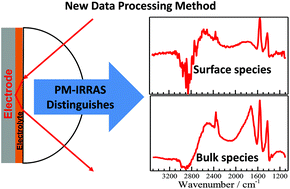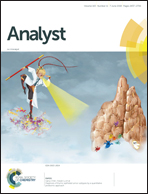The utility of polarization modulation infrared reflection absorption spectroscopy (PM-IRRAS) in surface and in situ studies: new data processing and presentation approach†
Abstract
Infrared spectroscopy is a powerful non-destructive technique for the identification and quantification of organic molecules widely used in scientific studies. For many years, efforts have been made to adopt this technique for the in situ monitoring of reactions. From these efforts, polarization modulation infrared reflection absorption spectroscopy (PM-IRRAS) was developed three decades ago. Unfortunately, because of the complexity of data processing and interpretation, PM-IRRAS had been avoided in lieu of the single potential alteration infrared spectroscopy (SPAIRS) and subtractively normalized interfacial Fourier transform infrared (SNIFTIR). In this work, we present a new approach for PM-IRRAS data processing and presentation, which provides more insight into in situ and surface studies besides dramatically improving the S/N. In this new approach, we recommend three complementary methods of data treatment (



 Please wait while we load your content...
Please wait while we load your content...